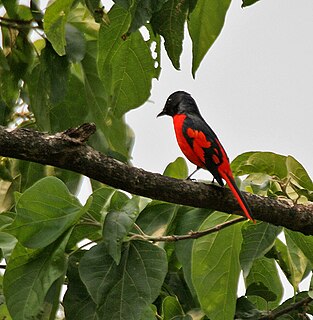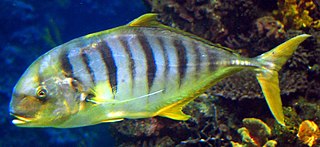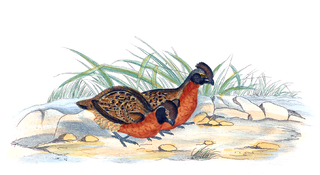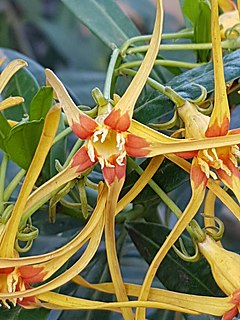
The scarlet minivet is a small passerine bird. This minivet is found in tropical southern Asia from India, Sri Lanka to southern China, Indonesia, and the Philippines. They are common resident breeding birds in forests and other well-wooded habitats including gardens, especially in hilly country. While the male of most subspecies are scarlet to orange with black upper parts, the females are usually yellow with greyish olive upper parts. Several former subspecies have been elevated to a species status in recent works. These include the orange minivet. All subspecies have the same habits of gleaning for insects and are often seen in mixed-species foraging flocks, usually foraging in small groups, high up in the forest canopy.

Wandering spiders (Ctenidae) are a family of spiders that includes the Brazilian wandering spiders. These spiders have a distinctive longitudinal groove on the top-rear of their oval carapace similar to those of the Amaurobiidae. They are highly defensive and venomous nocturnal hunters. Despite their notoriety for being dangerous, only a few members of Phoneutria have venom known to be hazardous to humans, but the venoms of this family are poorly known, so all larger ctenids should be treated with caution.

The Texas toad is a species of medium-sized toad that occurs in the southern United States and northern Mexico. It breeds in temporary water pools after heavy rains.

The golden trevally, also known as the golden kingfish, banded trevally or king trevally, is a species of large marine fish classified in the jack and horse mackerel family Carangidae, and the only member of the monospecific genus Gnathanodon. The golden trevally is widely distributed throughout the tropical and subtropical waters of the Indian and Pacific Oceans, ranging from South Africa in the west to Central America in the east, extending to Japan in the north and Australia in the south. The species predominantly occupies inshore waters where it inhabits both reef and sandy substrates. The golden trevally is easily distinguished from its relatives by its fleshy, rubbery lips and unique colouration, which ranges from bright yellow with black bars as a juvenile to a golden-silvery colour as an adult. It is known to grow to 120 cm in length and 15 kg in weight. The golden trevally schools as a juvenile, often closely following larger objects including sharks and jellyfish. The species uses its protractile jaws to suck out prey from the sand or reef, and consumes a variety of fish, crustaceans and molluscs. Spawning aggregations gather at night at different times of the year throughout its range. The golden trevally is a considerable constituent of several Middle Eastern fisheries and being of minor importance to many others, with a worldwide annual catch of 1187 t to 3475 t recorded between 2000 and 2010. The golden trevally is a popular gamefish, taken by bait, lure, fly and also spear throughout its range. Several Asian countries currently farm the fish in caged aquaculture. Due to their brilliant colouration, juveniles are popular in marine aquaria.

Cheilocostus speciosus, or crêpe ginger, is a species of flowering plants in the family Costaceae. Some botanists have now revived the synonym Hellenia speciosa for this species.

The large Japanese field mouse is a nocturnal species of rodent in the family Muridae. It is endemic to Japan.
Oecomys speciosus, also known as the savannah oecomys, arboreal rice rat, or Venezuelan arboreal rice rat, is a species of rodent in the genus Oecomys of family Cricetidae. It ranges over northeastern Colombia and much of Venezuela, including the island of Trinidad. This rodent lives in tropical rainforest and tropical dry forest, including secondary forest and gallery forest, as well as in savanna habitat.

The rufous-breasted wood quail is a species of bird in the family Odontophoridae. It is found in Bolivia, Ecuador, and Peru primarily on the east side of the Andes between 800 and 2000m in elevation.

The Lodgepole chipmunk is a species of rodent in the family Sciuridae. It is found in the U.S. state of California at elevations from 1,500 to 3,000 metres. The Lodgepole chipmunk has a variety of common names including: Tahoe chipmunk, Sequoia chipmunk, Mt. Pinos chipmunk, and San Bernardino chipmunk.

The Philippine gray flying fox is a species of flying fox in the family Pteropodidae. It is found in Indonesia and the Philippines. Its natural habitat is subtropical or tropical dry forests. It is threatened by habitat loss.
Copelatus speciosus is a species of diving beetle. It is part of the subfamily Copelatinae in the family Dytiscidae. It was described by Régimbart in 1892.

Crocus speciosus, with common name Bieberstein's crocus, is a species of flowering plant in the genus Crocus of the family Iridaceae. The plant is native to northern and central Turkey, the Caucasus, northern Iran, Crimea.
- Crocus speciosus subsp. ilgazensisB.Mathew - Turkey
- Crocus speciosus subsp. speciosus - Turkey, Iran, Caucasus, Crimea
- Crocus speciosus subsp. xantholaimosB.Mathew - Sinop Province in Turkey

Strophanthus speciosus, commonly known as the forest poison rope, is a tree, shrub or woody climber which is native to southern Africa.

Maratus speciosus, sometimes called the coastal peacock spider, is an Australian species of jumping spider. They are only known to inhabit the vegetation of the coastal sand dunes of southwestern Western Australia. Like other Maratus spiders, the males of the species engage in a courtship display during which they raise their third pair of legs and their abdomen, presenting their colorful opisthosomal plate to potential female partners. Unlike other Maratus, however, the males of this species have a set of bright orange hairs (setae) along both edges of the opisthosoma which only become visible during this display.
Diallomus fuliginosus, is a species of spider of the genus Diallomus. It is endemic to Sri Lanka.
Diallomus is a genus of Asian wandering spiders first described by Eugène Simon in 1897. As of April 2019 it contains only two species, both found in Sri Lanka. Originally placed with the Zoridae, it was moved to Ctenidae in 2003.
Burmesarchaea is a diverse extinct genus of spiders, placed in the family Archaeidae. The type species Burmesarchaea grimaldii was first described in 2003 and least 13 more species have been assigned to the genus. The genus has been exclusively found in Cretaceous Burmese amber, which is dated to 99 million years ago.

Poecilothomisus is a genus of spiders in the family Thomisidae. It was first described in 1895 by Simon. As of 2017, it contains only one species, Poecilothomisus speciosus, found in northern Australia.
Philodromus speciosus is a species of running crab spider in the family Philodromidae. It is found in the United States and Canada.











